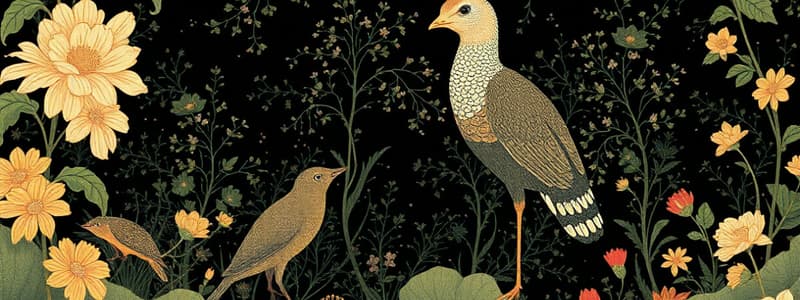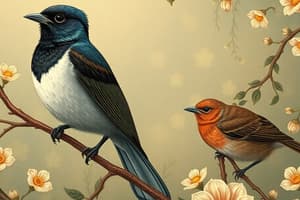Podcast
Questions and Answers
An introduced herbivore species begins to heavily graze on a specific type of plant that was previously ungrazed. What is the most likely initial impact on the ecosystem?
An introduced herbivore species begins to heavily graze on a specific type of plant that was previously ungrazed. What is the most likely initial impact on the ecosystem?
- A decrease in the overall plant diversity as the previously ungrazed plant thrives.
- An increase in the population of a predator that primarily consumes this plant.
- A stabilization of the ecosystem due to the new herbivore filling an empty niche.
- A reduction in the population of native herbivores that compete with the introduced species. (correct)
An introduced plant species outcompetes native plants for sunlight and water. Certain native herbivores can't consume the introduced plant. What is the most likely long-term consequence?
An introduced plant species outcompetes native plants for sunlight and water. Certain native herbivores can't consume the introduced plant. What is the most likely long-term consequence?
- A shift in the introduced plant's growth pattern, making it palatable to the native herbivores.
- An increase in overall biodiversity as new niches are created.
- A population decline in native herbivores and subsequent effects on their predators. (correct)
- An increase in the native herbivore population due to reduced competition among plants.
A species is introduced into an environment. Which of the following scenarios would MOST likely result in the introduced species failing to establish a stable population?
A species is introduced into an environment. Which of the following scenarios would MOST likely result in the introduced species failing to establish a stable population?
- The introduced species faces intense competition from a native species for a similar food source. (correct)
- The introduced species reproduces quickly and consumes a large amount of available resources without directly impacting other species.
- The introduced species exhibits a unique adaptation that allows it to access a previously untapped food source.
- The introduced species readily integrates into the existing food web, becoming prey for several native predators.
A remote island ecosystem has no native large predators. If a large predator is introduced, what is the most likely initial effect on the native species?
A remote island ecosystem has no native large predators. If a large predator is introduced, what is the most likely initial effect on the native species?
An introduced rodent species begins to rapidly reproduce in a grassland ecosystem. What is the MOST likely initial effect this will have on the native snake population?
An introduced rodent species begins to rapidly reproduce in a grassland ecosystem. What is the MOST likely initial effect this will have on the native snake population?
What is a 'domino effect' in the context of introduced species?
What is a 'domino effect' in the context of introduced species?
What is the most likely outcome for a native species that cannot survive alongside an established invasive species?
What is the most likely outcome for a native species that cannot survive alongside an established invasive species?
Which of the following scenarios BEST exemplifies how organisms adapt to both their environment and the other organisms within it?
Which of the following scenarios BEST exemplifies how organisms adapt to both their environment and the other organisms within it?
If a highly adaptable introduced species enters a balanced ecosystem, what is the MOST likely long-term outcome?
If a highly adaptable introduced species enters a balanced ecosystem, what is the MOST likely long-term outcome?
Why are invasive species often more successful in non-native environments compared to their native habitats?
Why are invasive species often more successful in non-native environments compared to their native habitats?
Co-evolution often creates a balance between predators and prey. What happens when an invasive species is introduced, disrupting this balance?
Co-evolution often creates a balance between predators and prey. What happens when an invasive species is introduced, disrupting this balance?
A remote island ecosystem has evolved in isolation for millennia. A new invasive predator is introduced. Which of following characteristics would make the ecosystem MOST vulnerable to collapse?
A remote island ecosystem has evolved in isolation for millennia. A new invasive predator is introduced. Which of following characteristics would make the ecosystem MOST vulnerable to collapse?
Nutria, a large South American rodent, was introduced into coastal wetlands of the United States. They consume large quantities of wetland vegetation, leading to habitat loss. What is the MOST likely long-term consequence of this introduction?
Nutria, a large South American rodent, was introduced into coastal wetlands of the United States. They consume large quantities of wetland vegetation, leading to habitat loss. What is the MOST likely long-term consequence of this introduction?
What is the primary difference between a 'native species' and an 'introduced species' in a particular ecosystem?
What is the primary difference between a 'native species' and an 'introduced species' in a particular ecosystem?
In an environment with limited resources, what determines whether a newly introduced species will survive?
In an environment with limited resources, what determines whether a newly introduced species will survive?
Flashcards
Adaptation
Adaptation
The process where organisms become suited to their environment, including other organisms.
Dual Adaptation
Dual Adaptation
Organisms must adapt to both their environment and the other organisms around them to survive.
Introduced Species
Introduced Species
A species living outside its native environment, brought there by human activity.
Native Species
Native Species
Species naturally found in an area, not introduced by humans.
Signup and view all the flashcards
Ecological Balance
Ecological Balance
The condition of balance among different species in an ecosystem.
Signup and view all the flashcards
Introduced species impact
Introduced species impact
When an introduced species begins to breed and affect other organisms in the ecosystem.
Signup and view all the flashcards
Introduced species dying
Introduced species dying
The term used for if the introduced species isn't adapted to the environment or other organisms.
Signup and view all the flashcards
New population
New population
If a new species can find a way to survive the environment and all of the other organisms around it and begins to breed.
Signup and view all the flashcards
Ecological Impact of Introduced Species
Ecological Impact of Introduced Species
Introduced species compete for resources, alter grazing, and shift predator-prey dynamics, impacting native species.
Signup and view all the flashcards
Domino Effect of Introduced Species
Domino Effect of Introduced Species
When one species affects another, which in turn affects others in a sequence.
Signup and view all the flashcards
Local Extinction
Local Extinction
The disappearance of a species from a specific area, though it may exist elsewhere.
Signup and view all the flashcards
Invasive Species
Invasive Species
Non-native species whose introduction causes economic or ecological harm.
Signup and view all the flashcards
Invasive Species Success
Invasive Species Success
Native species aren't adapted to introduced species, which can reproduce unchecked without predators.
Signup and view all the flashcards
Co-evolution Disruption
Co-evolution Disruption
Species evolve together, balancing predator-prey relationships. This is disrupted when a species is moved to a new habitat.
Signup and view all the flashcards
Lack of Natural Controls
Lack of Natural Controls
Without natural predators or defenses in their new environment, populations grow unchecked potentially harming local environment.
Signup and view all the flashcardsStudy Notes
- Organisms have to be adapted to their environment to survive, but also must be adapted to other species in their environment.
Introduced Species
- Introduced species are those living outside their native environment due to human activity.
- For an introduced species to survive, they must adapt to the environment and coexist with existing organisms.
- If an introduced species survives and breeds, it can impact the ecosystem and its native species.
- Native species are naturally found in an area, not introduced by humans.
Alteration of Ecological Balance
- Ecological balance refers to the equilibrium among different species in an ecosystem.
- Introduced species can compete with native species for resources, alter grazing patterns, and change predator-prey dynamics.
- An introduced herbivore can change grazing patterns, target specific plants, or outcompete native herbivores.
- Introduced plants compete with native plants for water, sunlight, and nutrients.
- If only certain herbivores can eat the introduced plant, native plant numbers may decline, impacting other herbivores.
- Introduced large predators can significantly impact ecosystems lacking native large predators.
- A single new species can impact multiple native species populations.
Effects of Introduced Species Have Chain Reaction
- Introduced species can trigger a domino effect by affecting native species, which in turn impact other species.
- Local extinction occurs when a species disappears from a local area.
- Local extinction of native species often results when an introduced species becomes established.
- Mongooses introduced in Hawaii to control rats now threaten native bird species.
- Tilapia and snakehead fish introductions have led to the extinction of native fish species.
- Many grass-covered hills in California consist of introduced species.
- In parts of Australia, the California poppy, a native Californian plant, has become widespread.
- Invasive species (also called non-native species) cause economic or ecological harm upon introduction.
- Invasive species threaten or cause the extinction of native species or dominate landscapes.
Mongoose Invasive Species
- Native species lacking adaptations to introduced species are more vulnerable.
- Birds in India have developed defense mechanisms against mongooses, which are native there.
- Introduced species may lack predators in their new environment, leading to unchecked reproduction.
- Co-evolution between predators and prey creates balance, which is disrupted when one species is moved to a new area.
Studying That Suits You
Use AI to generate personalized quizzes and flashcards to suit your learning preferences.




